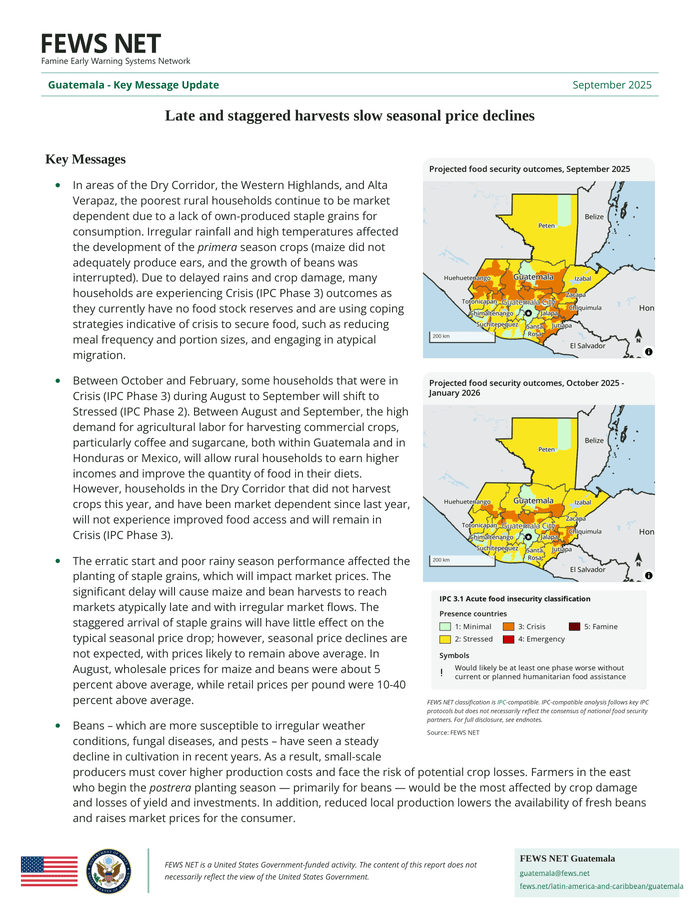Guatemala Food Security Outlook Update: Late and staggered harvests slow seasonal price declines, September 2025 – Guatemala | ReliefWeb
Skip to main content
Guatemala
Format
Analysis
Source
Posted
1 Oct 2025
Originally published
30 Sep 2025
Origin
View original
Attachments
Key Messages
In areas of the Dry Corridor, the Western Highlands, and Alta Verapaz, the poorest rural households continue to be market dependent due to a lack of own-produced staple grains for consumption. Irregular rainfall and high temperatures affected the development of the primera season crops (maize did not adequately produce ears, and the growth of beans was interrupted). Due to delayed rains and crop damage, many households are experiencing Crisis (IPC Phase 3) outcomes as they currently have no food stock reserves and are using coping strategies indicative of crisis to secure food, such as reducing meal frequency and portion sizes, and engaging in atypical migration.
Between October and February, some households that were in Crisis (IPC Phase 3) during August to September will shift to Stressed (IPC Phase 2). Between August and September, the high demand for agricultural labor for harvesting commercial crops, particularly coffee and sugarcane, both within Guatemala and in Honduras or Mexico, will allow rural households to earn higher incomes and improve the quantity of food in their diets. However, households in the Dry Corridor that did not harvest crops this year, and have been market dependent since last year, will not experience improved food access and will remain in Crisis (IPC Phase 3).
The erratic start and poor rainy season performance affected the planting of staple grains, which will impact market prices. The significant delay will cause maize and bean harvests to reach markets atypically late and with irregular market flows. The staggered arrival of staple grains will have little effect on the typical seasonal price drop; however, seasonal price declines are not expected, with prices likely to remain above average. In August, wholesale prices for maize and beans were about 5 percent above average, while retail prices per pound were 10-40 percent above average.
Beans – which are more susceptible to irregular weather conditions, fungal diseases, and pests – have seen a steady decline in cultivation in recent years. As a result, small-scale producers must cover higher production costs and face the risk of potential crop losses. Farmers in the east who begin the postrera planting season — primarily for beans — would be the most affected by crop damage and losses of yield and investments. In addition, reduced local production lowers the availability of fresh beans and raises market prices for the consumer.
According to the August-October climate outlook from the Instituto Nacional de Sismología, Vulcanología, Meteorología e Hidrología, above-average rainfall is expected in the Northern Transversal Strip, the south, and parts of the east. According to the National Coordinator for Disaster Reduction of Guatemala, by mid-September, 49 emergencies related to heavy and irregular rains had already been reported. River overflows, floods, landslides, and mudslides have affected 500 people, damaged 310 homes, croplands, and roads, interrupting the movement of people and goods. Given the forecast of an above-average hurricane season, FEWS NET is continuously monitoring both the progression of the season and the possible formation of significant climatic events and their potential impacts.
Report details
Primary country
Source
Format
Themes
Language
Share report link
Related Content


Dining and Cooking